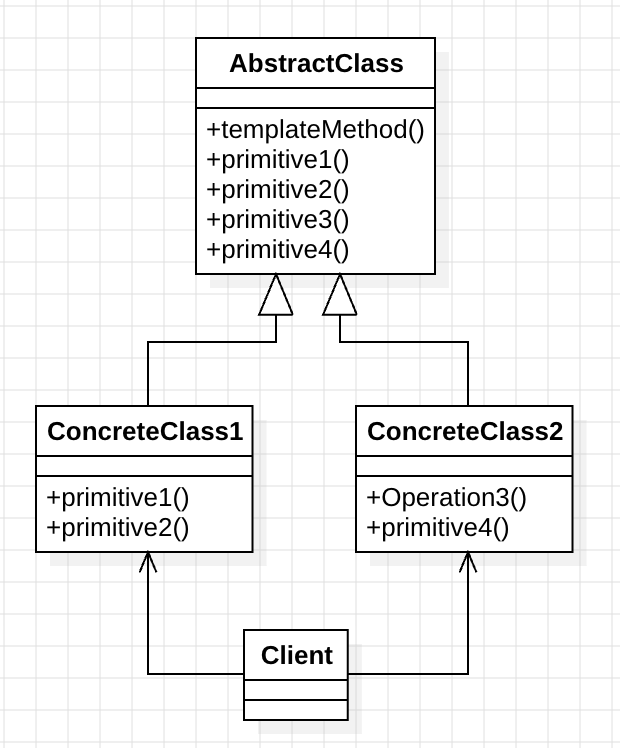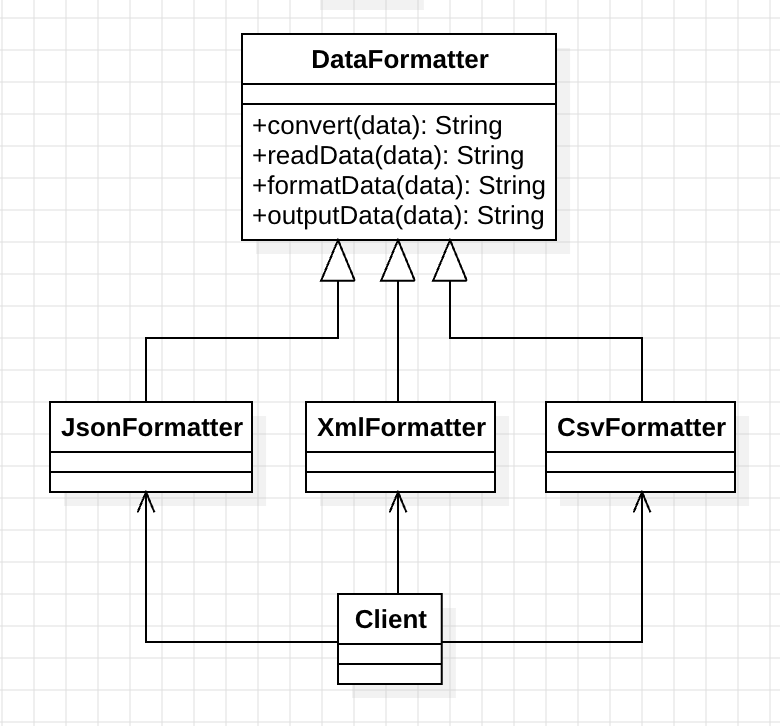Design Pattern (26) Template Method Pattern: Defining Algorithm Skeleton, Enhancing Code Reusability and System Extensibility
You can download the Design Pattern series code from this design_pattern repo.
Requirements
When designing a data format conversion system, we need to meet the following requirements:
1. Multi-format Support Requirements
Support conversion functionality for multiple data formats:
- JSON Format Conversion: Convert data to JSON format
- XML Format Conversion: Convert data to XML format
- CSV Format Conversion: Convert data to CSV format
2. System Extensibility Requirements
The system must have good extensibility capabilities. When business needs to add other formats (such as YAML, Protocol Buffers), it should be able to integrate quickly without affecting existing functionality.
3. Process Consistency Requirements
Maintaining core consistency of conversion processes is a key requirement. Regardless of which format conversion, all must follow standard processes:
- Read raw data
- Format data content
- Output final results
4. Code Quality Requirements
Avoid duplicate code generation, improve code maintainability and readability.
Object-Oriented Analysis (OOA)
After understanding the requirements, we clarify the system’s core problems through object-oriented analysis.
First, let’s observe the current system architecture:

Recognizing Forces
If we don’t apply design patterns, we’ll face the following core problems:
1. Code Duplication Problem
Each format’s conversion logic contains the same processing steps. These common steps are repeatedly written in various implementations, causing code redundancy.
When we have 10 formats, we might have 10 copies of almost identical process code.
2. Violates Open-Closed Principle (OCP)
Every time we need to add a format conversion, we must modify existing core conversion logic. This violates the “open for extension, closed for modification” design principle.
3. Maintenance and Extension Difficulties
Conversion logic for various formats is scattered in different places, lacking unified management. When core processes need adjustment, all related implementations must be modified synchronously, increasing error risks.
Applying Template Method Pattern (Solution) to Get New Context (Resulting Context)
After completing OOA analysis and recognizing problem cores, we can apply Template Method Pattern to elegantly solve these challenges.
Basic Concepts of Template Method Pattern
Template Method Pattern is an important behavioral design pattern. It defines an algorithm’s skeleton, allowing subclasses to override specific steps without changing the algorithm’s overall structure.
This pattern’s core idea is “define invariant processes in parent classes, implement variable details in subclasses,” working together with Strategy Pattern and State Pattern to form important components of behavioral patterns.
Let’s first understand Template Method Pattern’s standard structure:

Core Components of Template Method Pattern
Template Method Pattern contains two main roles:
1. AbstractClass (Abstract Class)
The abstract class is the pattern’s core, responsible for the following duties:
- Define Template Method: Encapsulate complete algorithm process skeleton
- Provide Common Implementation: Implement universal steps that don’t need changes
- Declare Abstract Methods: Let subclasses implement specific steps needing customization
2. ConcreteClass (Concrete Class)
Concrete classes inherit abstract classes, focusing on implementing business logic:
- Implement Abstract Methods: Provide concrete implementations for specific steps
- Follow Established Processes: Cannot change algorithm structure defined by parent class
Here’s Template Method Pattern’s specific application in our system:

Object-Oriented Design (OOP)
Based on Template Method Pattern’s architectural analysis, we begin concrete object-oriented design.
Core Design Philosophy
We’ll create an abstract data formatter as a template, defining standard conversion processes. Various concrete format converters inherit this template, implementing their respective formatting logic.
Implementation Details
AbstractClass: DataFormatter
abstract class DataFormatter {
// Template Method - Define complete conversion process
fun convert(data: Map<String, Any>): String {
val rawData = readData(data)
val formattedData = formatData(rawData)
return outputData(formattedData)
}
// Common step - All formats use same data reading logic
private fun readData(data: Map<String, Any>): String {
return data.toString()
}
// Abstract step - Implemented by subclasses for specific formatting logic
protected abstract fun formatData(data: String): String
// Abstract step - Implemented by subclasses for specific output formats
protected abstract fun outputData(data: String): String
}
ConcreteClasses: Specific Format Converters
Each concrete format converter focuses on implementing its own specific formatting logic:
class JsonFormatter : DataFormatter() {
override fun formatData(data: String): String {
return "{\"data\": \"$data\"}" // Simulate JSON formatting
}
override fun outputData(data: String): String {
return "JSON Output: $data"
}
}
class XmlFormatter : DataFormatter() {
override fun formatData(data: String): String {
return "<data>$data</data>" // Simulate XML formatting
}
override fun outputData(data: String): String {
return "XML Output: $data"
}
}
class CsvFormatter : DataFormatter() {
override fun formatData(data: String): String {
return data.replace(", ", "\n") // Simulate CSV formatting
}
override fun outputData(data: String): String {
return "CSV Output: $data"
}
}
Client: Client Usage Example
Client code demonstrates how to use different format converters:
fun main() {
val data = mapOf("name" to "John", "age" to 30, "city" to "New York")
val jsonFormatter = JsonFormatter()
println(jsonFormatter.convert(data))
val xmlFormatter = XmlFormatter()
println(xmlFormatter.convert(data))
val csvFormatter = CsvFormatter()
println(csvFormatter.convert(data))
}
Execution Results
Program execution output results:
JSON Output: {"data": "{name=John, age=30, city=New York}"}
XML Output: <data>{name=John, age=30, city=New York}</data>
CSV Output: name=John\nage=30\ncity=New York
Conclusion
Through Template Method Pattern application, we successfully solved core problems faced by the data format conversion system.
Core Advantages of the Solution
1. Significantly Improved Code Reusability
Common conversion process logic is centrally implemented in abstract classes, completely avoiding code duplication problems. All format converters share the same core process, ensuring consistency.
2. Greatly Enhanced System Extensibility
When adding any format conversion functionality, only need to:
- Inherit
DataFormatterabstract class - Implement
formatData()andoutputData()two methods - No need to modify any existing code
3. Fully Complies with Important Design Principles
- Single Responsibility Principle (SRP): Core process control completely separated from specific format logic
- Open-Closed Principle (OCP): System open for extension, closed for modification
Applicable Scenarios and Practical Applications
Template Method Pattern is particularly suitable for the following business scenarios:
Data Processing Domain
- Multiple data format conversion processes (JSON, XML, CSV, YAML)
- Data validation processing (unified validation processes for different data sources)
- Data cleaning and standardization processing
Document Generation Domain
- Multi-format report generation (PDF, Excel, Word)
- Document template processing for different styles
- Batch document processing systems
Workflow Management
- Standardized business process handling
- Unified management of multi-stage tasks
- Template-based design for approval processes
Summary
Template Method Pattern provides an elegant and practical solution. It not only ensures system core process consistency but also establishes solid architectural foundations for flexible and efficient functional expansion.
This pattern’s core value lies in “define skeleton, flexible filling,” allowing developers to quickly respond to changing business requirements while maintaining system stability.
In behavioral design patterns, Template Method Pattern works complementarily with Observer Pattern, Command Pattern and other patterns, collectively building a comprehensive software architecture design system. Mastering Template Method Pattern will add important design tools to your software development skills.
Enjoy Reading This Article?
Here are some more articles you might like to read next: